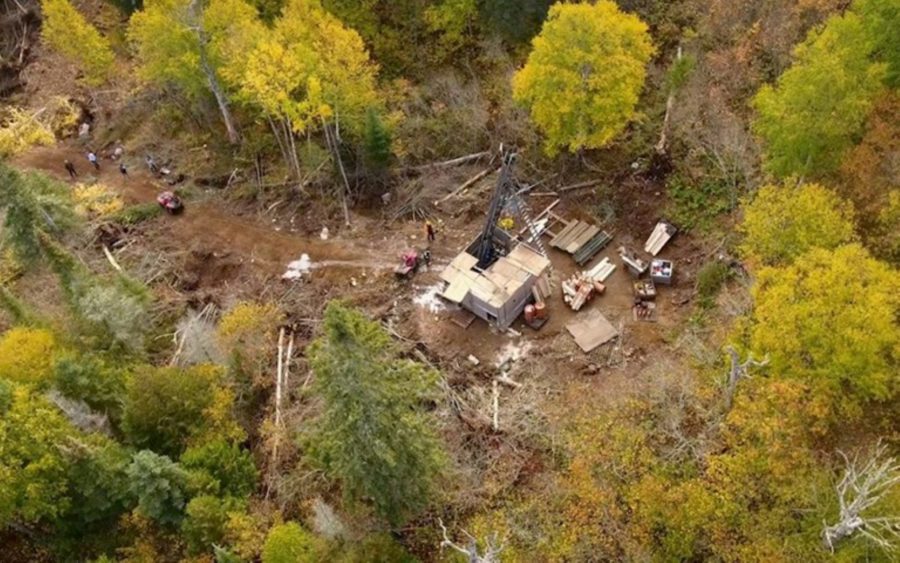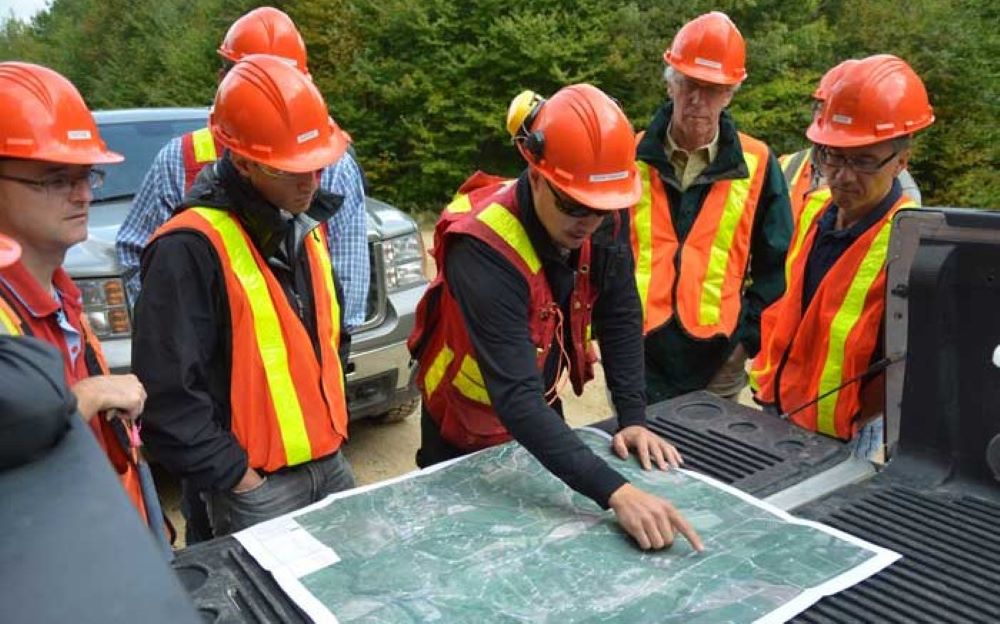Finding the metals that will power the future

Fireweed Zinc’s Macmillan Pass zinc-lead-silver project, in the Yukon. Credit: Fireweed Zinc
Base and battery metals assets, traditionally on the sidelines of gold developers, continue to gain prominence with the growing reach of electric vehicles. Based on numbers from the International Energy Agency, electric vehicles are expected to rise from 0.3% of the global car fleet in 2018 to 7% in 2030. This would translate to an addition of 116 million of EVs globally.
The base metals demand implications are significant: hybrid vehicles use anywhere from two to four times the nickel and twice the copper of conventional gasoline and diesel powered units, with battery powered EVs requiring even more of these metals.
The move towards fleet electrification is also expected to impact battery metal markets with cobalt currently a key component of EV batteries.
In 2018, the Democratic Republic of the Congo produced over 60% of the world’s cobalt . In August, Glencore announced plans to place the Mutanda mine, the world’s largest cobalt producer, on care and maintenance by the end of the year.
In addition, recent developments in zinc air batteries utilizing oxygen to extract power from the metal present potential for rechargeable applications.
These developments make base and battery metals an exciting target for exploration and development.
Below, we take a look at some active pre-production projects in western Canada, including British Columbia, the Yukon and the Northwest Territories. For the purposes of this article, we’ve focused on assets with existing resources and active news flow.
Turnagain
Giga Metals is focused on metallurgy and engineering at its Turnagain nickel-cobalt project in north-central British Columbia.
“We’re at the PEA level tradeoff study stage, lots of studies to do before we decide on an optimal processing route and size,” Mark Jarvis, the company’s CEO, told Canadian Mining Journal in November. “Our plan now is to figure out the best route to production then (take the project) to prefeasibility and feasibility… we want to advance the project to the shovel-ready (stage).”
A 2011 preliminary economic assessment (PEA) of the project featured a staged 43,400 t/d to 84,600 t/d open pit operation producing an average of 36,558 tonnes of nickel and 2,063 tonnes of cobalt per year in concentrate over a 27-year life. The initial capital cost was estimated at US$1.4 billion with an additional US$492 million required for an expansion in the fifth year of operations. The study pegged Turnagain’s net present value (NPV) at US$724 million using an 8% discount rate, and its internal rate of return (IRR) at 13.5%.
In October, the company released metallurgical test work results: locked cycle tests completed on the Horsetrail zone scheduled for production during the initial years of mine life delivered concentrate grades ranging from 18% to 22% nickel with recoveries on the order of 50% to 60%. Additional metallurgical testing is ongoing.
“(We can) send the concentrate to a smelter, but are also looking at taking the sulphide concentrate to sulphate form through a pressure oxidation process, the preferred product for battery metals,” Jarvis says. The company is in discussions with battery and car manufacturers about the option of direct concentrate sales. These parties would then make battery metal sulphates through their own pressure oxidation circuits.
Giga is currently working on an updated PEA, expected in the first quarter of 2020 with the goal of reducing the upfront capital requirements through a smaller startup operation.
In September, the company released an updated resource estimate for the project. Measured and indicated resources stand at 1.1 billion tonnes grading 0.22% nickel and 0.01% cobalt for a total of 5.2 billion lb. nickel and 312 million lb. cobalt. Inferred resources stand at 1.1 billion tonnes at 0.22% nickel and 0.01% cobalt for a total of 5.5 billion lb. nickel and 327 million lb. cobalt. The resources are open for expansion.
NICO
Fortune Minerals’ flagship asset is the 51.4-sq.-km NICO gold-cobalt-bismuth project, 160 km northwest of Yellowknife.
A 2014 feasibility study examined a potential 21-year, open pit operation with a high–grade underground starter mine and a 4,650 t/d mill. Capital costs, excluding working capital, were estimated at $589 million. After-tax NPV came in at $224 million (at a 7% discount rate), with a projected IRR of 15.1%. Operating costs were estimated at a negative US$5.03 per lb. of cobalt, net of byproduct credits.
Fortune is working on a progress report to update and optimize the study. “We are one of the few advanced cobalt development assets globally that is positioned to contribute an ethical supply of cobalt to the battery industry,” says Troy Nazarewicz, the company’s investor relations manager.
The NICO project consists of three ore lenses up to 1.3 km long, 550 metres wide and 70 metres thick, allowing for open pit mining widths in excess of 100 metres.
Fortune plans to produce a gold-cobalt-bismuth-copper concentrate onsite, that would then be transported to a metals processing plant to produce doré bars as well as cobalt, bismuth and copper products. The company is also looking at the option of concentrate and gold doré sales.
According to Robin Goad, the company’s president and CEO, a key advantage at NICO is the ability to achieve a high concentration ratio at the mine site: ores are subjected to flotation to produce a sulphide concentrate that is only 4% by weight of the original material and contains the recoverable metals. Fortune would then conduct a secondary flotation process on the bulk concentrate to separate the gold-cobalt and gold-bismuth concentrates. These could then be sold to a refinery after recovering the gold or, processed in a purpose-built refinery owned by the company through a high-pressure acid leach process. How–ever, the additional capital costs and risks associated with vertical integration would have to be weighed against the potential for better recoveries and greater revenues from higher value products.
“We are also looking at ways to reduce the capital costs associated with a refinery and one way would be to collaborate and share the costs of the processing plant,” Goad says. “We think that the key to financing the project will be attracting a strategic partner to contribute equity into a project finance solution… We are now expanding our pool of potential partners to include gold companies,” he adds, based on NICO’s gold reserve of more than 1 million oz.
In September, construction began on the 97-km Tlicho all-season road, which will provide access from the territorial highway system to the Whati community, located 50 km the south of NICO – a $200-million government funded initiative.
An environmental assessment has been completed for the potential mine and concentrator; negotiations with the Tlicho First Nation are underway regarding participation and access agreements.
The feasibility outlined open pit proven and probable reserves of 32.5 million tonnes grading 0.96g /t gold, 0.11% cobalt, 0.14% bismuth and 0.04% copper with underground proven and probable reserves adding 577,000 tonnes at 4.96 g/t gold, 0.1% cobalt, 0.17% bismuth and 0.02% copper. Total contained metal is estimated at 1.1 million oz. gold, 82.3 million lb. of cobalt, 102.1 million lb. of bismuth and 27.2 million lb. of copper.
Looking beyond NICO, Fortune has identified the Sue-Dianne copper-silver-gold deposit 25 km north, as a potential source of open pit mill feed.
Macmillan Pass
Fireweed Zinc’s principal asset is the 544-sq.-km Macmillan Pass project in the Yukon, 400 km east of Whitehorse.
The wholly owned Tom, Jason and Nidd properties are host to the Tom, Jason, Boundary Zone and End Zone deposits.
A 2018 PEA on the project outlined a 5,000 t/d underground operation with an initial open pit and ramp access underground. Total initial capital was estimated at $404 million with all-in operating costs at $82 per tonne processed. Inclusive of sustaining capital, adjusted cash costs would be US64¢ per lb. zinc net of byproduct credits. At an 8% discount rate, the project’s after-tax NPV came in at $448 million and the IRR at 24%.
An ore blend from the Tom and Jason deposits would be used to produce lead and zinc concentrates. The zinc concentrate would grade 58.4% zinc, with an 88.9% zinc recovery and the lead concentrate would grade 61.5% lead based on a 75.4% lead recovery.
Indicated resources stand at 11.2 million tonnes grading 6.59% zinc, 2.48% lead and 21.33 g/t silver for a total of 1.6 billion lb. zinc, 600 million lb. lead and 7.7 million oz. silver. Inferred resources stand at 39.5 million tonnes grading 5.84% zinc, 3.14% lead and 38.15 g/t silver for a total of 5.1 billion lb. zinc, 2.7 billion lb. lead and 48.4 million oz. silver.
In November, Fireweed received an upgraded permit for the project, allowing for larger exploration programs.
The Tom and Jason deposits are open for expansion with additional resource potential at the Boundary zone.
Step out and infill drilling completed on the Tom East and West zones in 2018 returned a number of intercepts with grades above the current resource.
Step-out drilling completed at Tom North in 2019 intersected mineralization outside of current resource boundaries at shallow depths. At Jason, there are additional higher-grade intercepts outside of current resources.
The Boundary zone, a near-surface area of mineralization located 15 km west of the Jason deposit, has been traced for almost 2 km and over widths of 200 metres to 800 metres and drilled down to 285 metres; it remains open.
Fireweed acquired a 100% interest in Macmillan Pass in 2018.
Kutcho Copper
Kutcho Copper’s principal project is the 170.6-sq-km. Kutcho property in northern British Columbia.
A 2017 prefeasibility study for the project outlined a 2,500 t/d underground operation (with a starter pit) producing an average of 33 million lb. copper and 42 million lb zinc annually. The study estimated that with initial capital costs of $221 million, the project has an after-tax NPV of $265 million and an IRR of 27.6% (using an 8% discount rate).
An updated feasibility study, led by Ausenco, is expected in the first half of 2020.
An updated resource estimate released in March outlined measured and indicated resources of 17.3 million tonnes grading 1.85% copper, 2.72% zinc, 0.49 g/t gold and 33.9 g/t silver with additional inferred resources of 10.7 million tonnes at 1.18% copper, 1.76% zinc, 0.26 g/t gold and 21.5g/t silver.
Current resources are contained within three volcanogenic massive sulphide deposits with four additional targets identified for follow up drilling nearby.
Metallurgical results from the Main Lens reported in September suggest recoveries in the range of 82.6% to 92.3% for copper and 63.2% to 84.2% for zinc. Associated concentrate grades ranged from 26.6% to 27.1% for copper and 58.6% to 59.7% for zinc. Recoveries from the Esso lens have been slightly higher .
In September, Kutcho started the B.C. environmental assessment process. Baseline studies were re-started in 2018, following the company’s acquisition of the project in 2017 from Capstone Mining. The company is working with First Nations groups in the area.
Additional exploration upside exists within the larger Kutcho property with a number of volcanogenic massive sulphide horizons identified.
Based on a US$65-million precious metals purchase agreement with Wheaton Precious Metals announced in August 2017, Kutcho estimates that 8% of project revenue is connected to a stream.
Prairie Creek
NorZinc holds 100% of the Prairie Creek project located 500 km west of Yellowknife.
The project has a long history: Mineralization at the property was discovered in 1928 and underground exploration started in the 1960s. A feasibility study was completed in 1980, followed by mine development. After a dramatic drop in the price of silver in the early 1980s, construction was suspended in 1982. NorZinc acquired the property in 1991.
In November, NorZinc received the land use permit for an all-season road to the Prairie Creek mine. Road construction is expected to start in 2020. NorZinc now has all of the major permits for mine construction and operation. The company is looking at potential buyers for concentrates from the project.
Mine construction is expected in two phases: construction of a winter road to Prairie Creek is planned for the first quarter of 2020. Main site construction is expected to follow in 2021 and 2022 with most of the underground development currently scheduled to begin in 2021.
A 2017 feasibility study outlined a 1,600 t/d underground mining operation producing an average of 95 million lb. zinc, 105 million lb. lead and 2.1 million oz. silver in concentrate annually in the first 10 years of operation at a total preproduction capital cost of $279 million. The associated NPV, at an 8% discount rate, is $188 million, with the IRR projected at 18.4%.
To finance the project, NorZinc plans to access either equity or an alternative (such as silver stream) next year, with bank debt or hybrid financing to follow.
In September, NorZinc announced the sale of a 1% net smelter return royalty on the Prairie Creek mine to an affiliate of Resource Capital Fund VI L.P. for $8 million. Resource Capital Funds currently holds 41% of the company’s shares.
Based on metallurgical tests results completed on quartz vein material, a zinc sulphide concentrate is expected to grade 59% zinc with a lead concentrate expected at 65% lead; recoveries of 90% are anticipated for both. An average of 86% of the silver is expected to be recovered to concentrates.
Four styles of mineralization have been identified on the property with quartz veins host to base metals mineralization the largest reserve contributor. These have been traced over 16 km.
The 74.9-sq.-km property is host to proven and probable reserves totalling 8.1 million tonnes at 23.1% zinc equivalent (8.64% zinc, 124.22 g/t silver and 8.1% lead). Total measured and indicated resources are 8.7 million tonnes grading 9.5% zinc, 8.9% lead and 136 g/t silver (25.6% zinc equivalent) for a total of 1.8 billion lb. of zinc, 1.7 billion lb. of lead and 38.1 million oz. of silver. Inferred resources add 7.1 million tonnes at 27.1% zinc-equivalent for 1.8 billion lb. of zinc, 1.2 billion lb. of lead and 37.6 million oz. silver.
Pine Point
Osisko Metals’ Pine Point project is located 42 km east of Hay River and covers a 65–km strike length.
The exploration focus at Pine Point is on prismatic deposits. These are high grade, vertically continuous bodies that extend up to 60 metres with typical widths of 15 metres to 50 metres.
Pine Point deposits lie on the south shore of Great Slave Lake, along a 70 km belt between Hay River and Fort Resolution. Drilling has identified 100 deposits within the belt with 50 developed by Cominco in the past.
An updated resource estimate is expected in the second quarter of 2020 alongside an initial preliminary economic assessment.
In November, the company released updated resource figures for the project: combined inferred resources stand at 52.4 million tonnes grading 4.64% zinc and 1.83% lead (6.47% zinc equivalent) for a total of 5.3 billion lb. of zinc and 2.1 billion lb. of lead. The pit constrained portion stands at 47.9 million tonnes.
Current Pine Point resources are contained within five deposits with the central core of the project (the East Mill, Central and North zones) host to 31.9 million tonnes grading 6.22% zinc equivalent.
In August, Osisko released initial flotation results from Pine Point drill core with zinc concentrate grades of 63.6% to 64.1% and lead concentrate grades of 67.9% to 72.1%. Zinc recoveries ranged from 93.1% to 94.5% and lead recoveries were between 87.4% and 91.4%. According to the company, these recovery numbers as well as concentrate grades are exceptional with no smelter or refinery penalties expected.
Mineralization remains open at depth and along strike. Compilation of gravity and topographic survey results is ongoing along with relogging and assaying of historic drill core.
Pine Point was discovered in 1898 with metals production between 1964 and 1987 when an estimated 64.3 million tonnes of ore were mined grading 7% zinc and 3.1% lead from 50 open pits and two underground mines.





Comments